[Via Satellite 02-25-2015] SES has awarded launches for two of its three recently announced satellites to SpaceX. Of the recently announced SES, 14, 15 and 16/GovSat, SES 14 and 16 will liftoff on Falcon 9 missions in 2017. The contracts further tighten the satellite operator’s relationship with SpaceX, whose ability to launch to Geostationary Transfer Orbit (GTO) was first vetted by the SES 8 mission in late 2013. SpaceX has also been busy laying the groundwork for its proposed constellation of 4,000 small satellites, making the company a new participant in the spectrum wars.
SES Launch Deals
Ordered from Airbus Defence and Space, SES 14 is an all-electric satellite designed to provide Direct-to-Home (DTH) and direct-to-cable services in the Americas, along with VSAT services both in C and Ku band. A multi-spot high throughput payload in Ku and Ka will deliver capacity for mobile backhaul, maritime and aeronautical services.
SES 16/GovSat is for the new joint SES-Luxembourg company LuxGovSat, and will support dedicated military frequencies in X and Ka band covering Europe, the Middle East and Africa with fully steerable spot beams. Orbital ATK is building the conventionally propelled spacecraft on the relatively new GEOStar 3 satellite bus. NATO will use a significant fraction of the satellite’s capacity, with the rest available for government and institutional customers.
“SpaceX is an important launch partner to realize our new fleet investment and growth program,” Martin Halliwell, CTO of SES said in a statement.
The company’s next satellite to launch, SES 9, is also with SpaceX and is slated for later this year.
In Defense of Ka band
Aside from winning new launch contracts, SpaceX has also joined a number of satellite operators including ViaSat, EchoStar, Inmarsat and O3b Networks in cautioning the U.S. Federal Communications Commission (FCC) against short-circuiting the growth of Ka-band services. The regulatory agency is evaluating rules for fifth generation (5G) mobile radio services in bands above 24 GHz. Satellite operators are concerned that deploying new services above this band could negatively impact satellite services in Ka band (26.5 to 40 GHz). SpaceX, defending its recently announced plans for a constellation of roughly 4,000 satellites, submitted comments to the agency on Feb. 18.
“In any consideration of introducing 5G services into these bands, the commission is urged to take into account new satellite entrants and not just incumbent satellite operators and their existing or planned operations. SpaceX is committed to introducing a new [non-geostationary orbit] NGSO network in the Ka band, further enhancing competition and innovation for satellite services,” the company wrote in its reply comments to the FCC’s Notice of Inquiry (NOI).
SpaceX is opening a new division dedicated to manufacturing its constellation of small satellites in Seattle, Wash. In its NOI, SpaceX said its satellite network will operate in multiple frequency bands, including Ka band to provide broadband for fixed and mobile users around the world. Of specific concern is that sharing Ka-band spectrum will result in interference issues, which could more severely impact a constellation like what SpaceX has in mind.
“SpaceX notes that, even in satellite uplink, bands there are potential challenges to sharing between intensive, high-power terrestrial operations and satellite services. Not only do satellite Earth station uplink operations have the potential to cause interference into terrestrial receive antennas, but aggregate interference from terrestrial operations could adversely impact satellite receive operations. These effects are particularly important to consider in the context of NGSO operations, where steerable Earth station transmit antennas would have a wider geographic impact and significantly lower satellite altitudes magnify the impact of aggregate interference from terrestrial transmissions,” the company wrote.
SpaceX aims to launch its constellation of Low Earth Orbit (LEO) broadband satellites in roughly five years time. Last month, Elon Musk, CEO and chief engineer of SpaceX, said that he estimates the project would cost $10 to $15 billion to create. The first iteration of the constellation would provide global coverage, with more advanced satellites orbited roughly every five years. Each satellite would weigh a few hundred kilograms, he said.
The post SpaceX Weighs in on FCC Spectrum Debate, Wins Two SES Launches appeared first on Via Satellite.
